A practical guide to bird watching in Sonoma County, California
(Unless otherwise indicated, all phone numbers are in the 707 area code)
A practical guide to bird watching in Sonoma County, California
(Unless otherwise indicated, all phone numbers are in the 707 area code)


Sonoma County Bird Finder and
Species Notes
Short entries here for 300 species are intended to show where a given bird is likely to be found in the county, what time of year is best to look for it, and whether it is abundant, less so, or uncommon. Bird names with links have pages with photos and detailed notes. I'm still adding these individual species pages--131 down, 169 to go! (Note that some species pages may be temporarily incomplete placeholders as I add pages).
KEY
•Abundance: (Color coded to make it clear at a glance which birds are most common)
Common (Permanent resident or abundant seasonally)
Less common (usually present, or present in season, but not abundant)
Unusual (migrants present seasonally, but only for a short period or in small numbers; or birds that may be confined to a limited habitat)
Uncommon or Rare (One or only a few accepted county sightings, or birds that are noted only once or twice yearly).
Birds are listed in rough order of abundance within their groups.
•Seasonality: Winter (Win); Spring; Summer (Sum); Autumn; Year-round (YR); Sporadic, Vagrant, Accidental, or Rare (SVAR). Intended as a rough guide only--many "summer" birds, for example, arrive in early spring and leave in late autumn, and some may overwinter.
•Locations given are some of the most likely places to find each bird in the county (not exhaustive, and, obviously, birds will be found in places not listed here. Again, intended as a rough guide.)
*Birds marked with an asterisk are birds known to breed in Sonoma County, according to Sonoma County Breeding Bird Atlas (Betty Burridge, Ed., Madrone Audubon Society, 1995)
**Sora confirmed as a county breeder for the first time, in spring 2011
DUCKS, GEESE and SWANS (Family Anatidae)

•*Canada Goose: YR, Spring Lake, Lake Ralphine, Bodega Farm Pond, Shollenberger Park, Ellis Creek Water Treatment Facility, Nagasawa Park
•Brant: YR, but mostly Win, throughout Bodega Harbor, but often best seen from areas around Westside Park, Diekmann's Store, or Smith Brothers Road
•Cackling Goose: Mostly Win, Bodega Farm Pond, Shollenberger Park
•Mute Swan: YR, Ellis Creek Water Treatment Facility, Shollenberger Park
•Greater White-fronted Goose: Occasional winter flyovers, mostly in the Bodega Bay area and around Ellis Creek Water Treatment Facility
•Ross's Goose: SVAR, One resident bird at Lucchesi Park, sporadic winter sightings at Shollenberger Park, Bodega Bay
•Snow Goose: SVAR, Occasional winter flyovers. Very occasionally seen at the Bodega Farm Pond, sporadic winter sightings at Shollenberger Park
•Tundra Swan: SVAR, Has been seen very occasionally at Shollenberger Park and Ellis Creek Water Treatment Facility, typically a single bird that lingers during the winter months

Perching Ducks
•*Wood Duck: YR Brush Creek Trail, Spring Lake, Doyle Park
Dabbling Ducks (genus Anas)
•*Mallard: YR, Common on ponds, streams in much of the county. Spring Lake Lagoon, Lake Ralphine, Bodega Farm Pond, Laguna de Santa Rosa, Place to Play Park, Brush Creek Trail, Santa Rosa Creek
•*Northern Shoveler: Win, Shollenberger Park, Ellis Creek Water Treatment Facility
•American Wigeon: Win, Bodega Farm Pond, Doran Beach (entrance pond), Ellis Creek Water Treatment Facility, Shollenberger Park
•*Northern Pintail: Win, Shollenberger Park
•*Gadwall: YR, Ellis Creek Water Treatment Facility, Doran Beach (entrance pond), occasionally at Spring Lake and Lake Ralphine
•*Cinnamon Teal: YR (but mostly early spring) Ellis Creek Water Treatment Facility, Shollenberger Park
•Green-winged Teal: Win, Ellis Creek Water Treatment Facility, Shollenberger Park, Spring Lake sporadically
•Blue-winged Teal: YR, but uncommon, Shollenberger Park, Ellis Creek Water Treatment Facility
•Eurasian Wigeon: Win, Doran Beach (entrance pond), Ellis Creek Water Treatment Facility
Pochards (genus Aythya)
•Canvasback: Win, Bodega Farm Pond, Shollenberger Park, Ellis Creek Water Treatment Facility
•Greater Scaup: Win, Shollenberger Park, Ellis Creek Water Treatment Facility
•Lesser Scaup: Win, Shollenberger Park
•Ring-necked Duck: Win, Bodega Farm Pond, occasionally Lake Ralphine
•Redhead: SVAR, Has been seen at Bodega Farm Pond, Shollenberger Park
•Tufted Duck: SVAR, Has been seen at Shollenberger Park
Eiders
•Harlequin Duck: Win, Bodega Harbor, Bodega Head, Campbell Cove, but sporadic
•Long-tailed Duck: SVAR, Seen sporadically at Bodega Bay
Sea Ducks
•Bufflehead: Win, Jenner, Goat Rock, Spring Lake, Lake Ralphine, Bodega Farm Pond, North End Bodega Harbor, Hole in the Head, Doran Beach
•Common Goldeneye: Port Sonoma, Nagasawa Park, Spring Lake, Porto Bodega
•Surf Scoter: YR (esp. Win), North End Bodega Harbor, Campbell Cove, Smith Brothers Rd., Sonoma coast
•White-winged Scoter: Win, Bodega Harbor, Campbell Cove. Sporadic
•Black Scoter: Win, Bodega Harbor. Sporadic to rare
•Barrow's Goldeneye: Win, Port Sonoma, Bodega Harbor, but very uncommon
Mergansers
•*Common Merganser: YR (but especially Win), Lake Ralphine, Place to Play Park, Russian River, Austin Creek, Gualala River
•Red-breasted Merganser: Win, Doran Beach, Porto Bodega, North-end Bodega Harbor, Campbell Cove
•Hooded Merganser: Win, Nagasawa Park, sporadic on various freshwater ponds
Stiff-tailed Ducks
•*Ruddy Duck: Win, Bodega Harbor, Lake Ralphine, Spring Lake, Place to Play Park, Lucchesi Park

NEW WORLD QUAIL (Family Odontophoridae)

•*California Quail: YR, common throughout the county in brushy areas, woodland edges, and in suburbia, common feeder bird. Spring Lake, Annadel State Park
•*Mountain Quail: YR, but elusive. Wooded high-elevation locations, mostly in the eastern port of the county--Sugarloaf Ridge State Park, Pine Flat Rd., Ida Clayton Rd.

PARTRIDGES, GROUSE, TURKEYS and OLD WORLD QUAIL (Family Phasianidae)
•*Wild Turkey: YR, Annadel State Park, Channel Drive, Pine Flat Rd., Howarth Park, common in parts of Santa Rosa, other cities, suburbs
•*Ring-necked Pheasant: YR, Reclamation Rd., open, grassy areas throughout the county
•*Blue Grouse: YR, but limited to the northwestern portion of the county in forested areas. King Ridge Rd., Rockpile Rd.

LOONS (Family Gaviidae)

•Common Loon: YR, but mostly Win, Throughout Bodega Harbor, but especially North end of harbor, Campbell Cove, Porto Bodega, Tides Wharf. Also, off Bodega Head, Goat Rock, Jenner
•Pacific Loon: Win, Throughout Bodega Harbor, but especially Bodega Head. Also North End Bodega Harbor, Campbell Cove. Jenner, Duncan's Landing
•Red-throated Loon: Win, Jenner, Goat Rock, Duncan's Landing, North End Bodega Harbor, Doran Beach near channel jetties, Campbell Cove, Bodega Head, Goat Rock, Duncan's Landing, Porto Bodega
•Yellow-billed Loon: SVAR, seen sporadically within Bodega Harbor
•Arctic Loon: SVAR Seen at Bodega Bay in 1995 and 1999

GREBES (Family Podicipididae)

•*Pied-billed Grebe: YR, fairly common on freshwater lakes and ponds. Spring Lake, Lake Ralphine, Hole in the Head, Place to Play Park, Shollenberger Park, Ellis Creek Water Treatment Facility
•Western Grebe: YR, Jenner, Goat Rock, throughout Bodega Harbor, but North End Bodega Harbor is a favorite hang-out, often with Clark's Grebe, allowing side-by-side comparisons of the two species, Campbell Cove, Bodega Head, Shollenberger Park, Port Sonoma
•Eared Grebe: Win, Common around Bodega Harbor, but especially North End Bodega Harbor, Campbell Cove, Bodega Head. Shollenberger Park, Occasionally seen at Spring Lake
•Horned Grebe: Win, Bodega Harbor generally, but North End Bodega Harbor, Campbell Cove, Bodega Head, Doran Beach. Shollenberger Park
•Clark's Grebe: YR, North End Bodega Harbor, often with Western Grebe, allowing comparisons. Bodega Head, Campbell Cove, Tides Wharf. Port Sonoma, Shollenberger Park
•Red-necked Grebe: Win, Jenner, Goat Rock, Duncan's Landing, Bodega Harbor generally, but especially Campbell Cove, Entrance to Bodega Harbor Channel, and near Bodega channel jetties at Doran Beach Park

CORMORANTS (Family Phalacrocoracidae)

•*Double-crested Cormorant: YR, Mouth of the Russian River, Spring Lake, Lake Ralphine, Place to Play Park, Laguna de Santa Rosa
•*Brandt's Cormorant: YR, Jenner, Goat Rock Beach, Duncan's Landing, Bodega Head
•*Pelagic Cormorant: YR, Jenner, Goat Rock Beach, Duncan's Landing, Bodega Head

PELICANS (Family Pelecanidae)
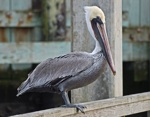
•American White Pelican: Sum (and autumn), Bodega Bay Mud flats, esp. Gaffney Point, Place to Play Park
•Brown Pelican: YR, but mostly Sum and Autumn, North End Bodega Bay, Porto Bodega, Bodega Bay and coast areas generally

HERONS, BITTERNS, and ALLIES (Family Ardeidae)
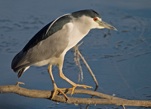
•*Great Egret: YR, Common in appropriate habitat in most of the county, Ninth St. Rookery during nesting season, Spud Point Crab Co. during nesting season
•*Snowy Egret: YR, Lake Ralphine, Spring Lake, Nagasawa Park, Place to Play Park, Ninth St. Rookery during nesting season
•*Great Blue Heron: YR, Gaffney Point, Spring Lake, Lake Ralphine, Shollenberger Park
•*Black-crowned Night Heron: YR, Hole in the Head, Laguna de Santa Rosa, Lake Ralphine, Ninth St. Rookery during nesting season
•Green Heron: YR, Spring Lake, Lake Ralphine
•*Cattle Egret: Win, Ninth St. Rookery during nesting season
•American Bittern: YR, Spring Lake, Laguna de Santa Rosa, Shollenberger Park

IBISES and SPOONBILLS (Family Threskiornithidae)
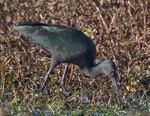
•White-faced Ibis: SVAR

BIRDS OF PREY

•*Turkey Vulture: YR Just look up. Common throughout the county.

•*Osprey: YR, Spring Lake. Lake Ralphine, Gaffney Point, Over Bodega Harbor generally, Mouth of the Russian River, Lake Sonoma
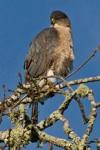
•*Red-tailed Hawk: YR, but numbers rise in winter, esp. along coast. Sugarloaf Ridge St. Park, Annadel St. Park, Bodega Head, Skaggs Island Rd. (south)
•*Red-shouldered Hawk: YR, Spring Lake, Place to Play Park, not uncommon in suburban settings
•*Northern Harrier: YR, but numbers rise in winter, esp. along coast. Sugarloaf Ridge St. Park, Annadel St. Park, Bodega Head, Skaggs Island Rd. (south)
•*White-tailed Kite: YR, Shollenberger Park, Helen Putnam Regional Park, Pine Flat Rd., Skaggs Island Rd. (south)
•*Cooper's Hawk: YR, but numbers rise in winter. Annadel State Park, Sugarloaf Ridge State Park, Spring Lake
•*Sharp-shinned Hawk: YR, but numbers rise in winter. Nagasawa Park, Annadel State Park, Sugarloaf Ridge State Park, Pine Flat Rd.
•Ferruginous Hawk: Win, but sporadic. Skaggs Island Rd. (south), Ramal Rd., Jenner
•*Golden Eagle: YR, but uncommon. Sugarloaf Ridge State Park, Pine Flat Rd., Ida Clayton Rd.
•Rough-legged Hawk: Win, but uncommon. Skaggs Island Rd. (south), Coleman Valley Rd.
•Bald Eagle: Win, uncommon--although numbers increasing. Has been seen at Laguna de Santa Rosa, Spring Lake, Lake Sonoma, mouth of the Russian River
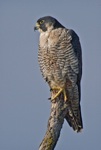
•*American Kestrel:YR, Annadel State Park, Sugarloaf Ridge State Park, Hood Mountain, Pine Flat Rd. Fairly common perched on wires throughout open areas of the county
•Merlin: YR, but numbers rise in winter. Annadel State Park, Sugarloaf Ridge State Park
•*Peregrine Falcon: YR, but numbers rise in winter. Doran Beach, Bodega Harbor, Bodega Head, Shollenberger Park, Ellis Creek Water Treatment Facility
•Prairie Falcon:Win, but uncommon. Has been sighted in the south part of the county and coastally

RAILS, GALLINULES and COOTS (Family Rallidae)

•*American Coot: YR (but especially winter), Spring Lake, Lake Ralphine, Ellis Creek Water Treatment Facility, Shollenberger Park, Nagasawa Park
•*Common Gallinule (Moorhen): YR, Spring Lake, Lake Ralphine, Ellis Creek Water Treatment Facility, Nagasawa Park
•*Virginia Rail: YR, Shollenberger Park, Spring Lake, Bodega Rail Ponds
•**Sora: Mostly Win, Shollenberger Park, Spring Lake, Bodega Rail Ponds, Ellis Creek Water Treatment Facility, Laguna de Santa Rosa
•*Black Rail: YR, Has been seen in the Port Sonoma area and other south county wetlands
•*Clapper Rail: YR, Has been seen in the Port Sonoma area and other south county wetlands

CRANES (Family Gruidae)
CRANES
•Sandhill Crane: SVAR

SHOREBIRDS
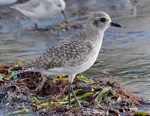
•*Killdeer: YR, Shollenberger Park, Ellis Creek Water Treatment Facility, Place to Play Park
•Black-bellied Plover: Win, spring, autumn, Porto Bodega, Shollenberger Park, Ellis Creek Water Treatment Facility
•Semipalmated Plover: Win, spring, autumn, Bodega Harbor, Porto Bodega, Doran Beach
•Pacific Golden Plover: Mostly autumn migration, sporadically overwinters, Shollenberger Park, Bodega Harbor, Doran Beach
•*Snowy Plover: Win, spring, autumn, Doran Beach
•American Golden Plover: SVAR, autumn migration. Noted at Shollenberger Park
Family Haematopodidae (Oystercatchers)
•*Black Oystercatcher: YR, Bodega Head, Porto Bodega. Rocky coastal areas generally
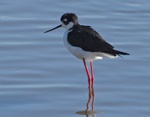
•*Black-necked Stilt: YR, Shollenberger Park, Place to Play Park, Skaggs Island Rd. (South), Bodega Harbor
•*American Avocet: Win, spring, autumn, Shollenberger Park
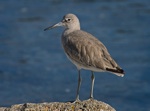
•Willet: Win, spring, autumn, Bodega Harbor, Tides Wharf, Smith Brothers Rd. Porto Bodega, Doran Beach, Port Sonoma, coastal areas generally
•Marbled Godwit: Win, spring, autumn, Bodega Harbor, Porto Bodega, Doran Beach, Port Sonoma, coastal areas generally
•Western Sandpiper: Win, spring, autumn, Bodega Harbor, Tides Wharf, Smith Brothers Rd. Porto Bodega, Doran Beach, coastal areas generally
•Least Sandpiper: Win, spring, autumn, Bodega Harbor, Tides Wharf, Smith Brothers Rd. Porto Bodega, Doran Beach, coastal areas generally
•Greater Yellowlegs: Win, spring, autumn, Shollenberger Park, Ellis Creek Water Treatment Facility, Place to Play Park, Laguna de Santa Rosa, Santa Rosa Creek at Willowside Rd.
•Long-billed Dowitcher: Win, spring, autumn, Shollenberger Park, Ellis Creek Water Treatment Facility, Place to Play Park
•Short-billed Dowitcher: Win, spring, autumn, Bodega Harbor, Gaffney Point. Coastal mud flats generally.
•Dunlin: Win, spring, autumn, Bodega Harbor, Gaffney Point. Coastal mud flats generally
•Sanderling: Win, spring, autumn, Bodega Harbor, Doran Beach, ocean beaches generally
•Black Turnstone: Win, spring, autumn, North End Bodega Harbor, Porto Bodega, Bodega Head
•Ruddy Turnstone: Win, spring, autumn, North End Bodega Harbor, Porto Bodega, Bodega Head
•Whimbrel: Win, spring and autumn migration, Bodega Harbor, Tides Wharf, Porto Bodega
•Long-billed Curlew: Win, spring, autumn, Shollenberger Park
•Wilson's Snipe: Win, Spring Lake, Ellis Creek Water Treatment Facility
•Red Phalarope: Spring, autumn migration (mostly latter), Bodega Harbor, Bodega Head, offshore coastal areas
•Red-necked Phalarope: Spring, autumn migration, mostly latter, Bodega Harbor, Bodega Head, offshore coastal areas
•*Wilson's Phalarope: Mostly autumn migration. Shollenberger Park, Ellis Creek Water Treatment Facility
•Lesser Yellowlegs: Mostly autumn, Shollenberger Park, Ellis Creek Water Treatment Facility
•*Spotted Sandpiper: YR, but mostly winter. Spring Lake, Lake Ralphine, streams and freshwater locations
•Surfbird: Win, Bodega Head
•Pectoral Sandpiper: Mostly autumn migration. Shows up from time to time at Shollenberger Park, Bodega Harbor
•Wandering Tattler: SVAR, Campbell Cove, Bodega Head, Doran Beach, Entrance to Bodega boat channel
•Red Knot: SVAR Bodega Harbor, Doran Beach
•Sharp-tailed Sandpiper: SVAR Has been seen at Shollenberger Park, Bodega Harbor

GULLS, TERNS, KITTIWAKES and SKIMMERS (Family Laridae)
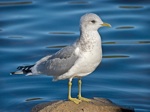
•*Western Gull: YR, Shollenberger Park, Lucchesi Park, The Tides Wharf, Porto Bodega, Campbell Cove, Doran Beach, throughout the Sonoma Coast
•Ring-billed Gull: YR, but especially winter, Shollenberger Park, Spring Lake, Lake Ralphine, Porto Bodega, Campbell Cove, Lucchesi Park
•California Gull: Mostly winter, Bodega Bay generally, Porto Bodega, Campbell Cove, Lucchesi Park, Lake Ralphine
•Elegant Tern: Sum, Bodega Bay generally, Porto Bodega
•Forster's Tern: Year-round, but mostly Autumn and Winter. Rare during June. Bodega Bay, South County coastal areas,
•Heermann's Gull: Summer and Autumn, Bodega Harbor generally, Porto Bodega, Doran Beach
•Mew Gull: Win, Porto Bodega, Bodega Harbor generally, Goat Rock Beach, Duncan's Landing and other coastal areas throughout the county. Occasionally appears at inland lakes
•Glaucous-winged Gull: Bodega Harbor, Bodega Head, Duncan's Landing, Campbell Cove, Lucchesi Park
•Herring Gull: Win, Coastal areas generally, Bodega Harbor
•Thayer's Gull: Win, Coastal areas generally, Duncan's Landing, Campbell Cove, Roberts Lake, Lake Ralphine
•Bonaparte's Gull: Win and during spring and fall migration, Bodega Head, Campbell Cove, Doran Beach, entrance to boat channel at Bodega Harbor
•Caspian Tern: Sum, Bodega Bay, Jenner/mouth of the Russian River
•Black-legged Kittiwake: Win, Bodega Head, Duncan's Landing, north county coastal areas--generally offshore
•Glaucous Gull: Win, Bodgea Head, Jenner, Duncan's Landing
•Common Tern: Mostly autumn, Has been noted at Bodega Harbor, Gaffney Point, Porto Bodega
•Arctic Tern: Mostly offshore during spring and fall migrations, but has been seen in Bodega Harbor, Doran Beach
A comparison of common gull heads in breeding and non-breeding plumages

PIGEONS AND DOVES (Family Colombidae)

•*Pigeon (Rock Dove): YR, The ubiquitous city pigeon.
•*Mourning Dove: YR, common throughout the county. Regular visitor at feeders.
•*Band-tailed Pigeon: YR, Bodega Harbor, Channel Dr., Pine Flat Rd., Cavedale Rd., Spring Lake, Arroyo Sierra Dr.
•Eurasian Collared-Dove: YR, increasingly widespread, but sporadic. Numbers growing, beginning to push out the native Mourning Dove in some locations. Reliably present at parking lot of the Sebastopol Community Center, near entrance to Laguna de Santa Rosa trails, Morris St., Sebastopol

OWLS
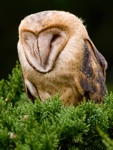
•*Barn Owl: YR, Most common in south and west county in open areas where farm ad other buildings provide shelter
Family Strigidae (Typical Owls)
•*Great Horned Owl: YR, Has nested at Spring Lake
•*Western Screech Owl: YR, common in inland oak woods.
•*Northern Pygmy Owl: YR, Sugarloaf Ridge State Park, Pine Flat Rd., Ida Clayton Rd., Armstrong Woods.
•*Northern Saw-whet Owl: YR
•*Spotted Owl: YR, uses evergreen and deciduous forested areas of of the county.
•Short-eared Owl: Win, Has been seen at Shollenberger Park, Reclamation Rd., Ramal Rd., Skaggs Island Rd. (south)
•Long-eared Owl: Win, but unusual. Has been noted at Pine Flat Rd., Annadel State Park
•*Burrowing Owl: Win, but scarce. Considered endangered.

GOATSUCKERS (Family Caprimulgidae)
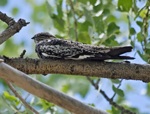
•*Common Poorwill: Mostly Sum. Restricted to higher elevations of inland mountains. Heard at Ida Clayton Rd., Pine Flat Rd., Cavedale Rd., Sugarloaf Ridge State Park, Hood Mountain
•*Common Nighthawk: Sum, but rare. Has been recorded only a few times, mostly at sights near the northwest corner of the county, near the coast.

SWIFTS (Family Apodidae)
SWIFTS
•*Vaux's Swift: Rio Lindo Academy, Healdsburg during migration
•*White-throated Swift: YR, but infrequent in Win, Ida Clayton Rd., Goat Rock

HUMMINGBIRDS (Family Trochilidae)
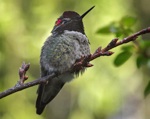
•*Anna's Hummingbird: YR, our most common hummingbird, and among the most common bird species in the county. Spring Lake, Lake Ralphine, Annadel State Park, Sugarloaf Ridge State Park, Ragel Ranch Park, Channel Dr., Melita Rd.
•*Allen's Hummingbird: Mostly Spring and Sum. Most common near the coast. Often confused with Rufous Hummingbird, which is less common.
•Rufous Hummingbird: Very occasionally seen during Spring migration. Often confused with Allen's Hummingbird, particularly females, which are virtually indistinguishable

KINGFISHERS (Family Alcedinidae)
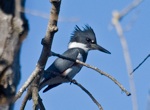
•*Belted Kingfisher: YR, Porto Bodega, Arroyo Sierra Dr., Brush Creek Trail, Spring Lake, Lake Ralphine

WOODPECKERS (Family Picidae)
WOODPECKERS
•*Acorn Woodpecker: YR, becoming more common inWinter. Throughout the wooded areas of the county, suburban areas, feeder visitor. Spring Lake, Arroyo Sierra Dr., Annadel State Park, Sugarloaf Ridge State Park
•*Downy Woodpecker:YR, throughout the wooded areas of the county, suburban areas, feeder visitor. Spring Lake, Lake Ralphine, Arroyo Sierra Dr., Annadel State Park, Sugarloaf Ridge State Park
•*Nuttall's Woodpecker: YR, throughout the wooded areas of the county, suburban areas, feeder visitor. Spring Lake, Lake Ralphine, Arroyo Sierra Dr., Annadel State Park, Sugarloaf Ridge State Park
•*Northern Flicker: YR, becoming more common inWinter. Throughout the wooded areas of the county. Spring Lake, Lake Ralphine, Arroyo Sierra Dr., Annadel State Park, Sugarloaf Ridge State Park
•*Hairy Woodpecker: YR, becoming more common inWinter. Throughout the wooded areas of the county. Lake Ralphine, Spring Lake, Sugarloaf Ridge State Park
•*RB Sapsucker: YR, Spring Lake, Arroyo Sierra Dr.
•*Pileated Woodpecker: YR, Annadel State Park, Sugarloaf Ridge State Park, Pine Flat Rd.
•Lewis's Woodpecker: Win, Spring, Autumn, but elusive

TYRANT FLYCATCHERS (Family Tyrannidae)
Flycatchers
•*Western Wood Pewee: Sum, Pine Flat Rd., Santa Rosa Creek at Willowside Rd., Spring Lake,
•*Olive-sided Flycatcher: Sum, Annadel State Park, Hood Mountain Regional Park, Sugarloaf Ridge State Park
Empidonax flycatchers

•*Black Phoebe: YR, our most common flycatcher. Spring Lake, Lake Ralphine, Place to Play Park, Nagasawa Park, Hole in the Head, Ragle Ranch Park,
•*Say's Phoebe: Win, Jenner Headlands, Doran Beach, Tolay Lake Regional Park, Shollenberger Park, Ellis Creek Water Treatment Facility
•Willow Flycatcher: Autumn migrant, Spring Lake
Myiarchus flycatchers
•*Ash-throated Flycatcher: Sum, Spring Lake, Lake Ralphine, Santa Rosa Creek at Willowside Rd., Helen Putnam Regional Park
•*Western Kingbird: Sum, Bodega Bay, Sugarloaf Ridge State Park, Shollenberger Park, Ellis Creek Water Treatment Facility
•Tropical Kingbird: SVAR Rare, seen very occasionally, usually in Autumn. Reported at Bodega Bay in 2011. Reported at Westside Park, Bodega Bay in Nov. 2010, and near Forestville in October 1977.

SHRIKES (Family Laniidae)
SHRIKES
•*Loggerhead Shrike: YR, but uncommon and numbers apparently declining. Seen sporadically at Bodega Bay, but mostly seen in the southeast of the county--Ramal Rd., Hudeman Slough, Viansa Winery, Sonoma Baylands Trail, Port Sonoma
•Northern Shrike: SVAR. A few recorded sightings in the winter months

VIREOS (Family Vireonidae)
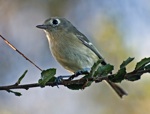
•*Hutton's Vireo: YR, common in live oak, blue oak, douglas fir forests. Often confused with Ruby-crowned kinglet. Jenner (Willow Creek Rd.), Santa Rosa Creek at Willowside Rd., Helen Putnam Regional Park, Place to Play Park, Spring Lake, Annadel State Park, Channel Dr., Sonoma State University campus
•*Warbling Vireo: Sum, Common throughout the county in appropriate woodland habitat. Santa Rosa Creek at Willowside Rd., Channel Dr., Annadel State Park, Lake Ralphine, Spring Lake, Sugarloaf Ridge State Park, Hood Mountain, Sonoma State University campus
•Cassin's Vireo: Sum, Present throughout the county in appropriate woodland habitats, but not abundant. Spring Lake, Annadel State Park, Channel Dr., Sugarloaf Ridge State Park, Mt. Hood

CROWS, RAVENS, JAYS and MAGPIES (Family Corvidae)
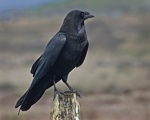
•*American Crow: YR, Common in most of the county. Spring Lake, Place to Play Park, urban and suburban areas
•*Western Scrub-jay: YR, Common in most of the county. Spring Lake, Bodega Harbor, Channel Dr., Annadel State park, Sugarloaf Ridge State Park
•*Common Raven: YR, mostly at higher elevations, becomes more common in Winter
•*Steller's Jay: YR, common in conifer/oak forest, mostly at higher elevations, becomes more common in Winter. Annadel State Park, Spring Lake, Sugarloaf Ridge State Park

LARKS (Family Alaudidae)
LARKS
•*Horned Lark: YR, but uncommon and numbers apparently declining.

SWALLOWS and MARTINS (Family Hirundinidae)

•*Barn Swallow: Sum, Common in much of the county. Spring Lake, Sugarloaf Ridge State Park, Place to Play Park, Shollenberger Park, Ellis Creek Water Treatment Facility
•*Violet-green Swallow: Place to Play Park, Riverfront Regional Park, Santa Rosa Creek at Willowside Rd., Spring Lake, Shollenberger Park
•*Cliff Swallow: Sum, Santa Rosa Creek at Willowside Rd., Jenner, Spring Lake, Lake Ralphine
•*Tree Swallow: Spring, Sum, Ragle Ranch Park, Spring Lake, Shollenberger Park, Lake Ralphine, Santa Rosa Creek at Willowside Rd.
•*Northern Rough-winged Swallow: Sum, Ragle Ranch Park, Spring Lake, Santa Rosa Creek at Willowside Rd., Shollenberger Park, Ellis Creek Water Treatment Facility
MARTINS
•Purple Martin: Bridge at the mouth of the Gualala River, sporadic sightings around the county

CHICKADEES and TITMICE (Family Paridae)
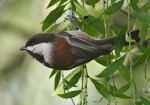
•*Oak Titmouse: YR, Present in wooded areas throughout the county, common feeder visitor
•*Chestnut-backed Chickadee: YR, Spring Lake, Annadel State Park, Channel Dr., Arroyo Sierra Dr., Brush Creek Trail, present in wooded areas throughout the county, common feeder visitor

LONG-TAILED TITS and BUSHTITS (Family Aegithalidae)
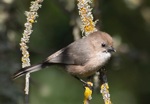
•*Bushtit: YR, Present in wooded areas throughout the county

NUTCHATCHES AND CREEPERS
Family Sittidae (Nuthatches)
•*White-breasted Nuthatch: YR, Present in wooded areas throughout the county, occasional feeder visitor
•*Red-breasted Nuthatch: YR, Sporadic around the county in suitable wooded areas. Bodega Harbor, Ida Clayton Rd., Pine Flat Rd., Coleman Valley Rd., Skaggs Spring Rd.
•Pygmy Nuthatch: YR, but confined to higher elevations with coniferous forest. Ida Clayton Rd., Armstrong Redwoods State Reserve
Family Certhiidae (Creepers)
•*Brown Creeper: YR, Spring Lake, Arroyo Sierra Dr., Strawberry School Park, Present in wooded areas throughout the county, occasional feeder visitor

WRENS AND DIPPERS

•*Bewick's Wren: YR, our most common wren. Hole in the Head, Lake Ralphine, Spring Lake, Annadel State Park, Channel Dr., Helen Putnam Regional Park
•*Marsh Wren: YR, Shollenberger Park, Ellis Creek Water Treatment Facility, Bodega rail ponds, Spring Lake
•*House Wren: Mostly Sum, Annnapolis Rd., Pine Flat Rd., Sugarloaf Ridge State Park, Annadel State Park
•*Pacific Wren (formerly Winter Wren): YR, but mostly confined to moist undergrowth in forested areas of north county. Annapolis Rd., Pine Flat Rd., Sugarloaf Ridge State Park
•*Rock Wren: SVAR Pine Flat Rd., Sugarloaf Ridge State Park
•*Canyon Wren: YR, but rare and restricted to cliff faces at higher elevations mostly in the eastern part of the county
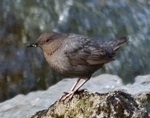
•*American Dipper: YR, but confined to fast, rocky streams. Big Austin Creek, Dry Creek, Big Sulphur Creek, North Geysers Rd., King Ridge Rd.

KINGLETS (Family Regulidae)
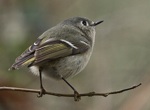
•Ruby-crowned Kinglet: Mostly Win, but also early spring, late autumn. Spring Lake, Lake Ralphine, Crane Creek Regional Park, Ragle Ranch Park, Bodega Bay rail pond area, Hole in the Head, Santa Rosa Creek at Willowside Rd., Spring Lake, Lake Ralphine
•*Golden-crowned Kinglet: YR, but not abundant. Mostly early autumn to late spring. Bodega Bay, Annadel State Park, Channel Dr., Helen Putnam Regional Park

SYLVIID WARBLERS (Family Sylviidae)
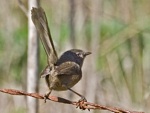
•*Wrentit: Jenner (Willow Creek Rd.), Campbell Cove, Sugarloaf Ridge State Park, Cavedale Rd., Spring Lake, Shollenberger Park, Pine Flat Rd.

GNATCATCHERS (Family Polioptilidae)

•*Blue-gray Gnatcatcher: Sum, mostly at higher elevations in eastern part of the county. Sugarloaf Ridge State Park, Annadel State Park, Pine Flat Rd.

THRUSHES (Family Turdidae)

•*Western Bluebird: YR, Jenner, Jenner Headlands, Ragel Ranch Park, Spring Lake, Lake Ralphine, Santa Rosa Rural Cemetery, Nagasawa Park, Annadel State Park, Sugarloaf Ridge State Park, Shollenberger Park, Ellis Creek Water Treatment Facility
•*American Robin: YR, but mostly Win. Bodega Bay, Ragle Ranch Park, Laguna De Santa Rosa, Santa Rosa Rural Cemetery, Place to Play Park, Nagasawa Park, Sonoma State University campus, Shollenberger Park, Ellis Creek Water Treatment Facility
•Hermit Thrush: YR, but more common in Win. Hole in the Head, Armstrong Woods State Park, Ragel Ranch Park, Spring Lake, Channel Dr.
•Swainson's Thrush: Sum, Prefers moist forested areas at lower elevations. Willow Creek Rd., Santa Rosa Creek at Willowside Rd., Spring Lake, Sonoma State University campus
•Varied Thrush: Irruptive, sporadic. Win, Many sightings in 2011. They seemed to be everywhere in 2006-2007. Ragle Ranch Park, Spring Lake, Lake Ralphine
•Townsend's Solitaire: Win, mostly confined to higher elevations. North peak of Mt. St. Helena appears to be the most reliable spot. Mt Hood.
•Mountain Bluebird: SVAR. Single birds have been recorded occasionally in the winter months at Laguna de Santa Rosa (Jan. 10), Dry Creek Rd. (Feb. 07), Jack London State Park (Feb. 06)

MOCKINGBIRDS and THRASHERS (Family Mimidae)
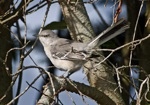
•*Northern Mockingbird: YR, common in suburban and urban locations around the county, Bodega Harbor, Ragle Ranch Park, Spring Lake, Lake Ralphine, Sonoma State University campus
•*California Thrasher: YR, but not abundant. Higher altitude areas in the eastern part of the county. Pine Flat Rd., Ida Clayton Rd., Mt. Hood, Cavedale Rd., Mt. St. Helena

STARLINGS (Family Sturnidae)
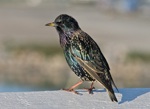
•*European Starling: Common in suburban and urban locations around the county, parks, agricultural land, grassy areas with light woods nearby. Jenner, Bodega Harbor, Spring Lake, Lake Ralphine, Sometimes seen in flocks of thousands in rural areas.

WAGTAILS and PIPITS (Family Motacillidae)
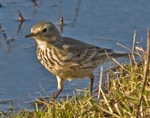
•American Pipit: Mostly Win, Ellis Creek Water Treatment Facility, Shollenberger Park

WAXWINGS (Family Bombycillidae)
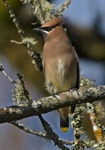
•Cedar Waxwing: Mostly autumn through spring, not uncommon in small to large flocks in urban and suburban settings, Spring Lake, Sonoma State University campus, Place to Play Park, Lucchesi Park, Shollenbergr Park
•Bohemian Waxwing: SVAR Irruptive at long intervals. Last recorded sighting appears to have been 1969

SILKY FLYCATCHERS (Family Ptilogonatidae)
SILKY FLYCATCHERS
•Phainopepla: SVAR, Only a few sightings have been recorded.

LONGSPURS and SNOW BUNTINGS (Family Calcariidae)
LONGSPURS
•Lapland Longspur: SVAR Win, has been seen at Jenner Headlands Preserve

WOOD WARBLERS (Family Parulidae)
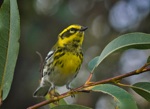
•*Yellow-rumped Warbler (Myrtle): Win, abundant. Hole in the Head, Campbell Cove, Spring Lake (distribution of the Myrtle and Audubon's types is different from place to place)
•*Yellow-rumped Warbler (Audubon's): Win, abundant. Hole in the Head, Campbell Cove, Spring Lake (distribution of the Myrtle and Audubon's types is different from place to place)
•*Orange-crowned Warbler: Sum, Ellis Creek Water Treatment Facility, Spring Lake, Lake Ralphine, Crane Creek Regional Park, Ragle Ranch Park
•*Common Yellowthroat: Shollenberger Park, Ellis Creek Water Treatment Facility
•Townsend's Warbler: Win, Spring, Autumn, Lake Ralphine, Strawberry School Park, Arroyo Sierra Dr.
•*Yellow Warbler: Lake Ralphine, Strawberry School Park, Arroyo Sierra Dr., Melita Rd., Channel Dr.
•*Wilson's Warbler: Lake Ralphine, Spring Lake, Strawberry School Park, Arroyo Sierra Dr., Channel Dr.
•*Black-throated Grey Warbler: Spring, Autumn migration, Lake Ralphine, Spring Lake, Strawberry School Park
•*Nashville Warbler: Spring and autumn migration. Mostly restricted to higher elevations in the eastern part of the county. Ida Clayton Rd., Pine Flat Rd.
•*Hermit Warbler: Sum. Mostly in dense woods in extreme northwest part of the county, but shows up at Spring Lake and elsewhere occasionally.
•*Yellow-breasted Chat: Sum, but uncommon and mostly restricted to dense riparian woodland habitats with thick undergrowth
•Black-and-white Warbler: Has been seen at Spring Lake (December 2011), Owl Canyon (October 2011, and September 8-9, 2010), Pt. Reyes (in neighboring Marin County)
•*MacGillivray's Warbler: Has been seen at Arroyo Sierra Dr. (Sep. 2010), Owl Canyon (Sep. 2010, Sep. 2008), Campbell Cove (Sep 2010)
•Palm Warbler: Win, but rare. Ordinance Rd., Santa Rosa (Feb. 2011). Has been seen at Shollenberger Park (April and Nov. 2005). Seen sporadically at Bodega Bay sites.
•Magnolia Warbler: Campbell Cove (Sep. 2010, Oct. 2010), Bodega Marine Lab trees (Oct. 2004)
•Black-throated Blue Warbler: Has been seen in the Bodega Marine Lab trees (Oct. 2010, Oct. 2004)

EMBERIZIDS (Family Emberizidae--TOWHEES, SPARROWS, JUNCOS)
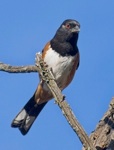
•*California Towhee: YR, Very common in appropriate habitat around the county, including suburban settings. Regular feeder visitor. Arroyo Sierra Dr., Strawberry School Park, Ragel Ranch Park, Lake Ralphine, Spring Lake, Annadel State Park, Sugarloaf Ridge State Park, Sonoma State University campus, Shollenberger park, Ellis Creek Water Treatment Facility
•*Spotted Towhee: YR, but seems more common in WinVery common in appropriate habitat around the county, including suburban settings. Regular feeder visitor. Arroyo Sierra Dr., Strawberry School Park, Ragel Ranch Park, Laguna De Santa Rosa, Lake Ralphine, Spring Lake, Annadel State Park, Sugarloaf Ridge State Park, Sonoma State University campus, Helen Putnam Regional Park, Shollenberger Park, Ellis Creek Water Treatment Facility
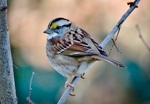
•*Song Sparrow: YR, common throughout the county. Favors open brushy areas, forest edges, and marshy areas. Jenner, Bodega Bay area, Ragel Ranch Park, Santa Rosa Creek at Willowside Rd., Laguna de Santa Rosa, Place to Play Park, Nagasawa Park, Lake Ralphine, Spring Lake, Channel Dr., Shollenberger Park, Ellis Creek Water Treatment Facility.
•*House Sparrow: YR, common throughout the county near human habitation.
•Golden-crowned Sparrow: Common in the winter months. Frequent winter feeder visitor. Hole in the Head, Ragle Ranch Park, Lake Ralphine, Spring Lake, Sonoma State University campus., Ellis Creek Water Treatment Facility, Shollenberger Park, Hudeman Slough
•*White-crowned Sparrow: YR, but more common in the winter months. Winter feeder visitor. Bodega Head, Hole in the Head, Laguna de Santa Rosa, Ragle Ranch Park, Spring Lake, Sonoma State University campus., Ellis Creek Water Treatment Facility, Shollenberger Park, Hudeman Slough
•*Savannah Sparrow: YR, especially coastally and in south county. In other areas, becomes more common in the winter months. Jenner, Duncan's Landing, Bodega Head, Laguna de Santa Rosa, Ellis Creek Water Treatment Facility, Shollenberger Park
•Fox Sparrow: Win, Campbell Cove, West Sonoma County Trail, Ragle Ranch Park, Spring Lake
•Lincoln's Sparrow: Win, Campbell Cove, West Sonoma County Trail, Ragle Ranch Park, Spring Lake, Nagasawa Park, Sonoma State University campus, Shollenberger Park, Tolay Regional Park
•Swamp Sparrow: Win, Shollenberger Park, Ellis Creek Water Treatment Facility
•White-throated Sparrow: Win, Occasional feeder visitor, but scarce. Laguna de Santa Rosa, Spring Lake, Melita Rd., Arroyo Sierra Dr., Shollenberger Park, Ellis Creek Water Treatment Facility
•*Lark Sparrow: YR, fairly common, but limited to mountainous areas in east county and grassy areas to the south and east of the county. Tolay Regional Park, Jenner, Jenner headlands, Coleman Valley Rd., Ida Clayton Rd., King Ridge Rd.,
•*Chipping Sparrow: Sum, Jenner, Pepperwood Ranch, Annadel State Park,
•*Rufous-crowned Sparrow: YR, Pine Flat Rd., Pepperwood Ranch, Ida Clayton Rd., King Ridge Rd.
•*Sage Sparrow: Sum but uncommon and restricted to higher elevations inland. Ida Clayton Rd., Sugarloaf Ridge State Park, Cavedale Rd.
•*Grasshopper Sparrow: Sum, but uncommon. Pepperwood Ranch, Jenner, Jenner Headlands,
•Clay-colored Sparrow: SVAR Unusual fall migrant, Has been occasionally noted at Bodega Bay locations. Single bird was present at Shollenberger Park from September 22-27, 2011
•*Black-chinned Sparrow: SVAR Mostly early Sum. Occasionally has been seen in parched rocky areas at higher elevations. Ida Clayton Rd., Pine Flat Rd., Geysers area
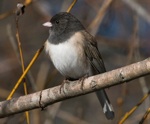
•*Dark-eyed Junco: YR, Very common in appropriate habitat around the county, including suburban settings. Regular feeder visitor. Arroyo Sierra Dr., Strawberry School Park, Ragel Ranch Park, Lake Ralphine, Spring Lake, Annadel State Park, Sugarloaf Ridge State Park, Sonoma State University campus, Helen Putnam Regional Park, Shollenberger park, Ellis Creek Water Treatment Facility
•Slate-colored Junco: SVAR, sporadically observed at feeders (including my own). Has been seen at Arroyo Sierra Dr., Spring Lake

CARDINALS, PIRANGA TANAGERS, and ALLIES (Family Cardinalidae)
PIRANGA TANAGERS
•*Western Tanager: Sum, Spring Lake, Sugarloaf Ridge State Park, not uncommon in suburbia during spring and autumn migration
GROSBEAKS
•*Black-headed Grosbeak: Sum, common during the summer months in forested areas. Pine Flat Rd., Lake Ralphine, Spring Lake, Channel Dr., Santa Rosa Creek at Willowside Rd., Annadel State Park, Sugarloaf Ridge State Park
•Rose-breasted Grosbeak: SVAR, Sum, but rare. Reported at Santa Rosa Creek at Willowside Rd.(June 2010).
BUNTINGS
•*Lazuli Bunting: Sum, Wooded areas at higher elevations. Pine Flat Rd., Sugarloaf Ridge State Park, Hood Mountain, Crane Creek`Regional Park

BLACKBIRDS (Family Icteridae)
MEADOWLARKS
•*Western Meadowlark: YR, but becomes more common in Win, Shollenberger Park, Ellis Creek Water Treatment Facility, Laguna de Santa Rosa, Spring Lake, Port Sonoma Reclamation Rd.
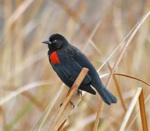
•*Brewer's Blackbird: YR, common countywide around human habitation, parks, coastal areas. Bodega Head, Porto Bodega, Duncan's Landing, Tides Restaurant parking lot, Bodega Farm Pond, Laguna de Santa Rosa, Lake Ralphine, Spring Lake, Shollenberger Park
•*Red-winged Blackbird: YR, common around water throughout the county. Bodega Head, Hole in the Head, Campbell Cove, Bodega rail ponds, Laguna de Santa Rosa, Ragle Ranch Park, Lake Ralphine, Spring Lake, Shollenberger Park, Ellis Creek Water Treatment Facility
•*Brown-headed Cowbird: YR, but more abundant in Sum. Often joins flocks of blackbirds, especially in the winter; hangs around cattle holding areas. Bodega Head, Porto Bodega, Santa Rosa Creek at Willowside Rd., Spring Lake, Sugarloaf Ridge State Park, Sonoma State University campus, Shollenberber Park
•Tricolored Blackbird: Sporadic, mostly Sum.
•Great-tailed Grackle: Shollenberger Park (Aug, Sep, Nov, Dec, 2010), Ellis Creek Water Treatment Facility (Aug, Sep, Oct, Nov, 2010), Goat Rock (Apr. 2006)
•Yellow-headed Blackbird: SVAR. Bodega Head (2011), Rohnert Park, CA (May 2007)
ORIOLES
•*Bullock's Oriole: Sum, Santa Rosa Creek at Willowside Rd., Spring Lake, Sonoma State University Campus, Ellis Creek Water Treatment Facility
•*Hooded Oriole: Sum, Santa Rosa Creek at Willowside Rd., Spring Lake, Sonoma State University Campus,

FRINGILLINE and CARDUELLINE FINCHES and ALLIES (Family Fringillidae)
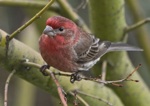
•*House Finch: YR, Very common in appropriate habitat throughout the county, including suburban settings. Regular feeder visitor. Bodega Bay area generally, Bodega Head, Arroyo Sierra Dr., Strawberry School Park, Ragel Ranch Park, Lake Ralphine, Spring Lake, Annadel State Park, Sonoma State University campus, Sugarloaf Ridge State Park, Hood Mountain, Shollenberger park, Ellis Creek Water Treatment Facility
•*Lesser Goldfinch: YR, Very common in appropriate habitat around the county, including suburban settings. Regular feeder visitor (the single most common species at my own feeder). Bodega Bay area generally, Arroyo Sierra Dr., Strawberry School Park, Ragel Ranch Park, Laguna de Santa Rosa, Place to Play Park, Nagasawa Park, Lake Ralphine, Spring Lake, Annadel State Park, Sonoma State University campus, Sugarloaf Ridge State Park, Hood Mountain, Shollenberger park, Ellis Creek Water Treatment Facility, Helen Putnam Regional Park, Pine Flat Rd.
•*American Goldfinch: YR, common in appropriate habitat around the county, including suburban settings. Regular feeder visitor. Bodega Bay area generally, Bodega Head, Hole in the Head, Santa Rosa Creek at Willowside Rd., Ragel Ranch Park, Laguna de Santa Rosa, Place to Play Park, Nagasawa Park, Lake Ralphine, Spring Lake, Arroyo Sierra Dr. Annadel State Park, Sonoma State University campus, Hood Mountain, Shollenberger park, Ellis Creek Water Treatment Facility, Helen Putnam Regional Park
•*Pine Siskin: Win, occasional winter feeder visitor. Jenner (Willowside Rd.), Arroyo Sierra Dr., Annadel State Park, Shollenberger Park
•*Purple Finch: YR, but somewhat more common in Win. Occasional winter feeder visitor. Laguna de Santa Rosa, Spring Lake, Annadel State Park
•Evening Grosbeak: Irruptive. Sporadic visitor in spring and autumn, with some birds overwintering. Recent outbreak Dec. 2010, around Apollo Way in Santa Rosa
•*Lawrence's Goldfinch: SVAR, Sum, but rare. Has been seen at Pine Flat Rd., Pepperwood Ranch, Tolay Regional Park,

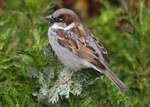
•*European Starling: Common in suburban and urban locations around the county, parks, agricultural land, grassy areas with light woods nearby. Jenner, Bodega Harbor, Spring Lake, Lake Ralphine, Sometimes seen in flocks of thousands in rural areas.
•Pigeon (Rock Dove): YR, The ubiquitous city pigeon.
•*House Sparrow: YR common throughout the county near human habitation.
•*Cattle Egret: Win, Ninth St. Rookery during nesting season (Mar to early June)
•Mute Swan: YR, Ellis Creek Water Treatment Facility, Shollenberger Park
•Eurasian Collared Dove: YR, increasingly widespread, but sporadic. Numbers increasing, beginning to push out the native Mourning Dove in some locations.

PELAGIC SPECIES (species usually seen well offshore, in open ocean)
•Sooty Shearwater: Mostly Spring through autumn
•Black-footed Albatross: Mostly summer, into late autumn
•Pink-footed Shearwater: Sum into autumn migration
•Buller's Shearwater: Late Sum, autumn
•Northern Fulmar: Sporadic, Win
•Black-vented Shearwater: Sporadic, autumn
•Ashy Storm-petrel: Autumn
•Pomerine Jaeger: Autumn migration
•Parasitic Jaeger: Autumn migration
•Short-tailed Shearwater: Sporadic autumn visitor
•Flesh-footed Shearwater: Sporadic autumn visitor
•Laysan Albatross: Rare, mostly autumn sightings
•South Polar Skua: Rare autumn migrant
•Fork-tailed Storm-petrel: Sporadic, rare, mostly spring, Sum, and autumn

ALCIDAE (Auks, etc.)
•Common Murre: YR, Common in coastal waters. Duncan's Landing, Bodega Head, Campbell Cove. Often nests at Point Reyes, in neighboring Marin County
•*Pigeon Guillemot: Mostly Sum, common along the coast. Has nested at Bodega Head. Bodega Head, Campbell Cove, near Boat channel jetties at Doran Beach
•Ancient Murrelet : Win, Uncommon but fairly regular offshore at Duncan's Landing, Bodega Head
•Marbled Murrelet: YR, but uncommon. Occasional seen off Duncan's Landing, Bodega Head
•Cassin's Auklet: YR, but fairly rare. Occasionally seen off Bodega Head. Noted fairly regularly on pelagic tours. Nests to the south of us, at the Farallon Islands
•Rhinoceros Auklet: YR, but mostly autumn, Win. Occasionally seen off Bodega Head. Noted fairly regularly on pelagic tours
•Horned Puffin: SVAR, has been noted at Salmon Creek, Wright's Beach, Bodega Head
•Tufted Puffin: YR, but rare--mostly autumn, Has been noted at Bodega Head, Jenner, but mostly at Bodega Canyon, on offshore boating trips. Numbers appear to be declining
© Colin Talcroft, 2009, 2010, 2011, 2012
Unless noted, all photos by the author. If you would like to use one of my images, please ask for permission for non-commercial use with proper credit or commercial use with proper compensation.